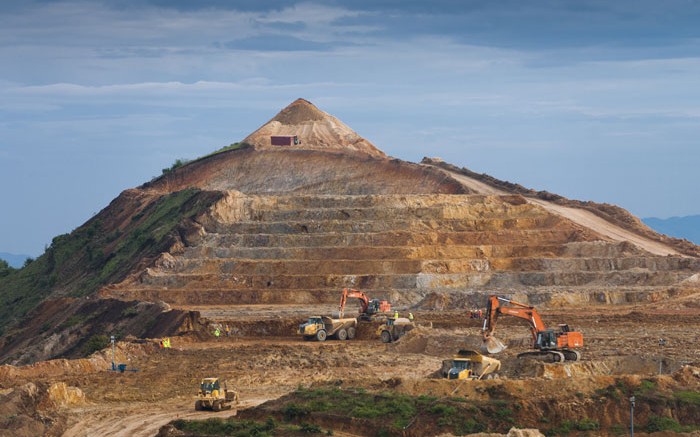Banro (BAA-T, BAA-X) intends to secure a larger financing package of up to US$100 million to get its delayed Namoya gold project in the Maniema province of the Democratic Republic of the Congo (DRC) into production by year-end.
Development at Namoya is slightly off-track due to heavy rains that pushed back construction of an access road, the Toronto-based producer revealed on March 7. This caused delays in delivering major plant components to the site, as the main 420 km long access road required extensive repair, driving up costs and pushing back first production from mid-year to the fourth quarter.
“Earlier this month we announced a 15% increase in the capital cost of Namoya beyond the original US$181 million [estimate] due to these delays. This brings the total capital cost to US$208 million,” John Clarke, the company’s interim CEO, said on a March 27 conference call. He notes that Banro has US$84 million left in capital expenditures at the project this year, after investing US$10 million at Namoya in the first quarter.
To ensure the firm could bring its second mine into production while optimizing its Twangiza gold mine in DRC’s South Kivu province, the company intends to expand its earlier-proposed financing.
On Feb. 21, Banro said it would secure up to US$90 million by offering US$40 million to $60 million of preferred stocks to BlackRock World Mining Trust and lining up US$30 million in credit facilities with two DRC commercial banks.
Meanwhile, Banro has established two credit facilities for US$15 million each with Rawbank and Ecobank at interest rates of 9% and 8.5%. It has replaced the previous preferred share component with three parts to collect up to another US$100 million — increasing its original package by US$40 million.
These components include offering common shares and Series A preferred shares to raise US$70 million on a best-efforts basis and lastly, closing a US$30-million preferred share private placement with BlackRock, BMO Capital Markets analyst Andrew Breichmanas explains in a note.
Proceeds from the common shares are anticipated to range from US$20 million to $40 million, while the preferred shares, priced at US$25 apiece, should bring in a total of US$30 million to $50 million.
Banro plans to offer 1.2-million Series B preferred shares — priced at US$25— to BlackRock for US$30 million in proceeds. But the private placement depends on the junior distributing the other preferred and common shares, and raising total proceeds of at least US$100 million, Breichmanas notes.
Clarke says that the public transaction of shares and preferred shares is expected to close in a few weeks. He reassured investors on the call that the common share component represents a less than 10% dilution.
But most investors appeared unimpressed with the new financing package, pushing Banro shares down 10% to $1.78, near its year low of $1.73 reached on March 7, 2013.
“The larger financing and dilutive common-share component raise concerns regarding the cost overruns at Namoya and near-term operational performance at Twangiza,” Breichmanas cautions.
Asked why Banro was raising a total of US$130 million, which is more than it needs to complete Namoya, Clarke replied that “the US$30-million [credit facility] is already drawn down, and we are making sure we are well funded for all eventualities to succeed on this project.”
But this is not the only asset the company needs to get on track this year. Banro is still working to bring Twangiza’s annual output to the promised 100,000 to 120,000 oz. range by expanding the plant’s operating capacity to 1.7 million tonnes per year from 1.3 million tonnes a year.
This year Banro has budgeted capital expenditures at US$35 million for Twangiza, US$94 million for Namoya and US$16 million for exploration. It also anticipates spending US$24 million on general corporate expenses, bringing its total capital requirements for 2013 to US$169 million.
According to its 2012 financial results, the junior exited last year with US$27 million in cash and equivalents.
This year the junior has lined up US$30 million in credit, with repayment on the Rawbank facility starting in October 2013, and on the Ecobank facility in March 2014.
If the company pulls off the US$100-million raise and all else stays on schedule, it could cover most of its 2013 capital requirements without eyeing another large funding.
For the year, Banro expects Twangiza to deliver 85,000 to 100,000 oz. and Namoya to contribute 16,000 to 22,000 oz., both within cash costs of US$700 to US$900 per oz. The range should be narrowed as the year progresses, Clarke says.
Last year Twangiza delivered 25,185 oz. since reaching commercial production on Sept. 1, 2012. Cash costs per oz. came in at US$887 per oz., with all-in costs at US$1,220 per oz. For these four months, it generated US$43 million in revenue from gold sales of 24,963 oz. at an average sales price of US$1,708 per oz.
Banro reported a net loss of US$4.5 million for 2012.
Year-to-date, the junior’s shares have dropped 47% in value. Banro closed April 8 at $1.51, within a 52-week range of $1.46 to $5.03.


Be the first to comment on "Banro eyes US$100M financing to get back on track"